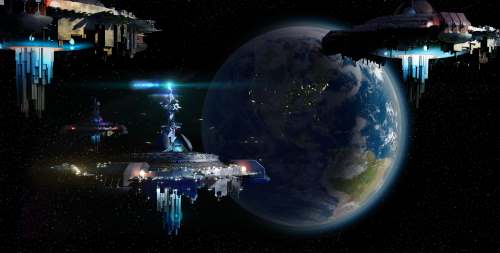Starmourn takes place over 1000 years in our future, and is in a universe populated by species who have had space flight for much, much longer than that. As a result, there's quite a wide range of technologies both basic and powerful in Starmourn.
However, just as there have been great leaps forward in terms of what's possible, so have civilizations lost knowledge periodically in civilization-wide setbacks resulting from, frequently, war.
And of course, as always, high technology is the realm of those with the means to afford it, or the skill to steal it. There are those living on backwater planets using technology barely better than what a 19th century human on Earth used.

The Commsphere
The commsphere or just the 'comm' is a decentralized interstellar communications network, roughly equivalent to the internet of 21st century Earth. It works by utilizing wormholes so small (sub-atomic size) that passing information through them is very cheap, even over vast distances.
Of course, there are places in Starmourn that are 'off the grid', and do not have contact with the commsphere.
Mindsims
Today, most beings are 'chipped' in a number of ways to make life easier. The chief among these is the almost universally-used mindsim. This is your personal datastore, your connection to the commsphere, and your all-around assistant, all running off a tiny chip inserted in your head when you were a child. They use uncrackable quantum encryption whose private key is the neural structure of your brain to stay secure, and they operate off the electrical energy your body generates.
Your mindsim is also key to your continued existence, because it is continually using an internal neural replicator (INR) to record your current brain state. That brain state is then uploaded to a cloning facility whenever you land on a planet or space station with one.
Quantum Power Cells
QPCs are the basis for power for anything up to, but not including, the starship level. They power everything from small blasters to entire homes, and underpin much of modern civilization.
QPCs are made from a form of astrium called HDS (High-Density Stabilized) astrium. It's a material left over from the remnants of the destruction of the Empyreal we know as Omega. Astrium was distributed all over Starmourn sector after that war, coalescing onto or into gravitational bodies. Large asteroids, planets, moons, and so on. It's a major target of mining corporations. It's found in the form of what's called low-density, destabilized astrium and goes through a process that turns it into HDS astrium.
First, it undergoes proton bombardment, which changes it into high-density, but still destabilized astrium. It's very dangerous in that state, and can be used in explosive devices, but generally isn't because it's so unstable in that form that it's just too dangerous to handle. Instead, it is then, very very carefully and under highly-controlled circumstances, changed into the final product by 'baking' it in a highly-focused gravitational field for a time, returning the high-density, fully stabilized Astrium that, while no longer explosive, can be tapped as an extremely efficient power source.
Skip Drives
Most races, before they joined the larger Galactic civilization, attempt to build ships that will go as fast as possible, up to light speed. Of course, as we know, going faster than light speed is impossible, and even getting matter to light speed requires infinite energy, so isn’t possible. Practically speaking, getting past about 90% of light speed starts to get geometrically expensive, getting worse the closer you approach 100%.
However, as all civilizations discover, there is no material that can survive contact with the minute particles of matter that are out there in space when you're going that fast. It will tear apart the hardest known materials. Shielding can withstand the impact, but the problem there is the energy generation required. In order to get a drive powerful enough to push something up towards light speed you need a very large drive, which means a large ship to shield, which means a lot of power generation to survive the constant barrage that will assault it at near light speed. It’s completely impractical basically – beyond prohibitively expensive. You might need something the size of a carrier to transport one individual that way and the energy required to accelerate something that large to near light speed, and protect it, is absolutely immense.
However, there is a solution that is far more efficient anyway: skip drives. Essentially, these take advantage of the fact that wormhole technology lets you skip between two spaces that are very close together very cheaply. These drives create a quick series of one-way wormholes spaced close together that let a ship move forward quickly without actually having a fatal velocity. The ship does have to be moving, as it has to physically pass through a wormhole, but this can happen rapidly at velocities that are very very fast but not so fast relative to space debris that the ship will get destroyed.
To go faster, the ship starts projecting wormholes further out ahead of itself, which gets very pricey. From a mechanics level, this means that space effectively has a built-in “air resistance” to traveling through it…sort of. If you stop generating wormholes you’ll still be moving forward, but at a suddenly much reduced ‘speed’, and the energy required to go faster scales non-linearly.
Visually, what you’d see if you watched a skip-drive capable ship travel is the ship repeatedly splitting into parts and rejoining itself forward of where it was, very very quickly. This allows the ship to effectively travel at faster than light speeds, with more capable skip drives able to generate wormholes further apart.
Of course, all ships need conventional drives as well, as they need to be moving to pass through a wormhole, and the faster they pass through it, the faster they can get to the next one. Thus, a ship's speed is dependent on both its skip drive and linear (normal non-warping movement) drives.
Shipforges
The Shipforges were large orbiting ship-building factories that orbited Earth. Because of the cost of escaping the gravity well of a planet, nobody builds serious spacecraft on the ground - it's much cheaper in the long run to build in space. While they were an advanced technology to the people of Earth, they were fairly insignificant in size compared to modern shipyards, like the Tetryon Drive Yards.

Voidgates and Aegispheres
Though of course it is possible, in theory, to travel linearly to anywhere in the galaxy or even universe, that’s very slow due to the sheer size involved, at least with any known tech. It seems likely or perhaps certain that the Empyreals had travel methods that allowed them to span the universe, and perhaps the Elder Races had travel methods we don't know of, but we are not left without tools here. There are ways to get around the galaxy. The most famous and capable of these are the Voidgates – artifacts left by a coordinated effort between two extinct Elder Races - the Utan Mir and the Vyar. We believe the Lha Ti were also involved, being creations of the Utan Mir, but they will say nothing about the Elder Races and they are the oldest of the Younger Races.
The Voidgates manifest as huge rings in space surrounded by an immense border of ‘machinery’ kilometers thick. Nobody has any idea what kind of material it’s made out of or how it works – the shielding around them is incredibly powerful however, and has never been penetrated to our knowledge.
Each Voidgate is powered by a nearby magnetar (a neutron star spinning at a high rate, generating the most powerful magnetic field of anything in the known universe) that appears to have some kind of nested semi-translucent quantum spheres around them that channel energy to the Voidgate.
There’s no way to ‘see’ there’s a magnetar inside, but the strong magnetic field can’t be mistaken. Nothing else in the known universe is as strongly magnetic. The magnetars themselves are about 20 kilometers wide, while the Voidgates they power are only a thousand km away. The shielding around them must dampen their magnetic output dramatically, as 1000 km from a normal magnetar would kill any life by disrupting the electron clouds in their atoms.
The other odd thing about the Voidgate magnetars is that they appear to have a far longer life than ordinary magnetars, which tend to run out of power after 10,000 years or so, while we know the Void Gates are about 1.1 million years old.
We're unsure why the Utan Mir and the Vyar placed the Voidgates where they did on occasion, but the hub and spoke system they make up is clear. Sometimes a magnetar is powering a single Voidgate (a spoke), and other times there are two or more around a magnetar (a hub).
The Voidgates themselves have, without question, one of the key forces in the development of Galactic civilization. Essentially, races that evolved near a Void Gate tended to either prosper through trade and early contact with more advanced civilizations or, just as often, find themselves enslaved or killed off by one of those aforementioned more advanced civilizations. Many wars have been fought to gain control of them, but in 3202 B.E. (about 4000 years ago), the Cleax - a race completely alien to our way of thinking and in seemingly limitless numbers - used the Voidgates to invade Starmourn Sector, wiping out multiple races and causing huge damage to many others.
The Y'saari - one of the few surviving Elder Races - beat them off with assistance from the Shen, and seized control of some of many of the key Voidgate hubs in Starmourn, using that leverage to charge passage through the Voidgates, payable only in their Covenant Mark, which has since, and as a direct result of, become the only currency that matters in Starmourn Sector.
The Y'saari then built, using scavenged Vyar technology, the Aegispheres - huge shield generators and fixed weapons emplacements that draw power from the magnetars near each Voidgate and shield themelves, the magnetar, and the Voidgate itself when desired.
Wetwiring
Wetwiring is dedicated, implanted medtech that will rapidly cure your wounds and that which afflicts you.
Like the mindsims, many beings - certainly any who intend to be anywhere near combat - will have wetwiring installed in them. This technology originated with the Bushraki and has only been prominent in Starmourn for a few hundred years, but has revolutionized survivability.
Wormhole Generation
While nobody in the known Galaxy can produce anything like a Voidgate in terms of distance and size, and while it’s also not known how Voidgates work, the science of wormhole generation is well-understood.
Wormholes can be opened between two locations, but the energy required to do so is potentially immense, and further energy is required to move things through them while preserving their atomic structure from quantum decay - an unfortunate side-effect of sending naked matter through a wormhole.
Effectively then, the cost to move something from point A to point B is a function of distance and size. The wormhole generators come in pairs, of course, and the further away they are from each other, the more expensive they get to build and power.
Two-way wormholes require 'spice' - isomorphic florinite - to open. The spice gets its name because long-term exposure to it causes symptoms resembling eating an exceptionally hot chile - permanent sweats on the back of neck and forehead, watering, puffy eyes, and a red face - before eventual death.
The bigger they are (to accommodate larger objects), the more expensive they are as well. If not for the cost of the wormhole generation equipment (whose cost to build scales up with how far away its pair is and how big of a thing it can transport), the actual energy cost to teleport someone 10 feet is fairly minimal. The problem is that the cost to do this scales non-linearly (though far from geometrically) as the distance increases.The result is that wormhole generators are not common every day devices. It’s always cheaper to linearly get somewhere, it may just take a lot more time. The furthest that it’s really practical for even governments and intercorps (intersystem corporations – ie the biggest of the big) to build wormhole generators is between the closest systems, and even then, the cost is very high. It is much cheaper to take a ship.
One-way wormholes are also possible, but the further away you’re trying to project the wormhole’s exit from the entrance, the less precise your control is. Controlled one-way wormhole generation is the key technology behind skipdrives on starships. One difference between one-way and two-way wormholes is that one-way wormhole generation requires and consumes vandium crystals.
Think we're pretty cool? Tell your friends!
